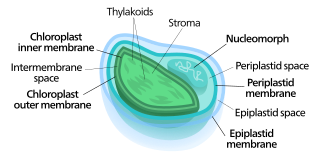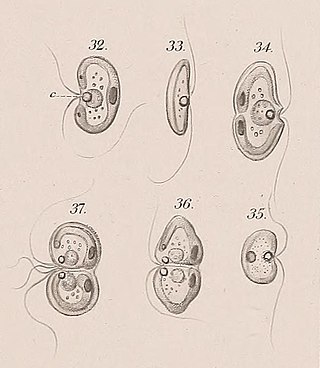Related Research Articles

Algae are any of a large and diverse group of photosynthetic, eukaryotic organisms. The name is an informal term for a polyphyletic grouping that includes species from multiple distinct clades. Included organisms range from unicellular microalgae, such as Chlorella, Prototheca and the diatoms, to multicellular forms, such as the giant kelp, a large brown alga which may grow up to 50 metres (160 ft) in length. Most are aquatic and lack many of the distinct cell and tissue types, such as stomata, xylem and phloem that are found in land plants. The largest and most complex marine algae are called seaweeds, while the most complex freshwater forms are the Charophyta, a division of green algae which includes, for example, Spirogyra and stoneworts. Algae that are carried by water are plankton, specifically phytoplankton.

A chloroplast is a type of membrane-bound organelle known as a plastid that conducts photosynthesis mostly in plant and algal cells. The photosynthetic pigment chlorophyll captures the energy from sunlight, converts it, and stores it in the energy-storage molecules ATP and NADPH while freeing oxygen from water in the cells. The ATP and NADPH is then used to make organic molecules from carbon dioxide in a process known as the Calvin cycle. Chloroplasts carry out a number of other functions, including fatty acid synthesis, amino acid synthesis, and the immune response in plants. The number of chloroplasts per cell varies from one, in unicellular algae, up to 100 in plants like Arabidopsis and wheat.

An endosymbiont or endobiont is an organism that lives within the body or cells of another organism. Typically the two organisms are in a mutualistic relationship. Examples are nitrogen-fixing bacteria, which live in the root nodules of legumes, single-cell algae inside reef-building corals and bacterial endosymbionts that provide essential nutrients to insects.

Symbiogenesis is the leading evolutionary theory of the origin of eukaryotic cells from prokaryotic organisms. The theory holds that mitochondria, plastids such as chloroplasts, and possibly other organelles of eukaryotic cells are descended from formerly free-living prokaryotes taken one inside the other in endosymbiosis. Mitochondria appear to be phylogenetically related to Rickettsiales bacteria, while chloroplasts are thought to be related to cyanobacteria.

A plastid, pl. plastids, is a membrane-bound organelle found in the cells of plants, algae, and some other eukaryotic organisms. They are considered to be intracellular endosymbiotic cyanobacteria.

Nucleomorphs are small, vestigial eukaryotic nuclei found between the inner and outer pairs of membranes in certain plastids. They are thought to be vestiges of primitive red and green algal nuclei that were engulfed by a larger eukaryote. Because the nucleomorph lies between two sets of membranes, nucleomorphs support the endosymbiotic theory and are evidence that the plastids containing them are complex plastids. Having two sets of membranes indicate that the plastid, a prokaryote, was engulfed by a eukaryote, an alga, which was then engulfed by another eukaryote, the host cell, making the plastid an example of secondary endosymbiosis.

The green algae are a group of chlorophyll-containing autotrophic eukaryotes consisting of the phylum Prasinodermophyta and its unnamed sister group that contains the Chlorophyta and Charophyta/Streptophyta. The land plants (Embryophytes) have emerged deep in the Charophyte alga as a sister of the Zygnematophyceae. Since the realization that the Embryophytes emerged within the green algae, some authors are starting to include them. The completed clade that includes both green algae and embryophytes is monophyletic and is referred to as the clade Viridiplantae and as the kingdom Plantae. The green algae include unicellular and colonial flagellates, most with two flagella per cell, as well as various colonial, coccoid (spherical), and filamentous forms, and macroscopic, multicellular seaweeds. There are about 22,000 species of green algae, many of which live most of their lives as single cells, while other species form coenobia (colonies), long filaments, or highly differentiated macroscopic seaweeds.

The Archaeplastida are a major group of eukaryotes, comprising the photoautotrophic red algae (Rhodophyta), green algae, land plants, and the minor group glaucophytes. It also includes the non-photosynthetic lineage Rhodelphidia, a predatorial (eukaryotrophic) flagellate that is sister to the Rhodophyta, and probably the microscopic picozoans. The Archaeplastida have chloroplasts that are surrounded by two membranes, suggesting that they were acquired directly through a single endosymbiosis event by phagocytosis of a cyanobacterium. All other groups which have chloroplasts, besides the amoeboid genus Paulinella, have chloroplasts surrounded by three or four membranes, suggesting they were acquired secondarily from red or green algae. Unlike red and green algae, glaucophytes have never been involved in secondary endosymbiosis events.

Nephroselmis is a genus of green algae. It has been placed in the family Nephroselmidaceae, although a 2009 study suggests that it should be separated into its own class, Nephroselmidophyceae. One species can be an endosymbiont of Hatena arenicola.

Ochrophytes, also known as heterokontophytes or stramenochromes, are a group of algae. They are the photosynthetic stramenopiles, a group of eukaryotes, organisms with a cell nucleus, characterized by the presence of two unequal flagella, one of which has tripartite hairs called mastigonemes. In particular, they are characterized by photosynthetic organelles or plastids enclosed by four membranes, with membrane-bound compartments called thylakoids organized in piles of three, chlorophyll a and c as their photosynthetic pigments, and additional pigments such as β-carotene and xanthophylls. Ochrophytes are one of the most diverse lineages of eukaryotes, containing ecologically important algae such as brown algae and diatoms. They are classified either as phylum Ochrophyta or Heterokontophyta, or as subphylum Ochrophytina within phylum Gyrista. Their plastids are of red algal origin.
Chromera velia, also known as a "chromerid", is a unicellular photosynthetic organism in the superphylum Alveolata. It is of interest in the study of apicomplexan parasites, specifically their evolution and accordingly, their unique vulnerabilities to drugs.

Guillardia is a genus of marine biflagellate cryptomonad algae with a plastid obtained through secondary endosymbiosis of a red alga.

The kathablepharids are a group of heterotrophic flagellates (Protists) the first species of which was described by Skuja in 1939 as Kathablepharis phoenikoston. His spelling was challenged because of non-compliance with botanical nomenclatural conditions, hence the alternative spelling Katablepharis. As the organism was heterotrophic and usually regarded as 'protozoan', and to favour stability, Skuja's original spelling has largely prevailed. With an anterior pocket and ejectisomes, the kathablepharids were thought initially to be cryptomonads. There were a variety of differences with Cryptomonas and other typical cryptomonads = cryptophytes, such as the thickness, length, and beat pattern of the flagella, their phagotrophic habitat, differences in the ejectisomes, and various features of their ultrastructure. The distinctive characteristics of the group were established from electron microscopical studies by Clay and Kugrens and Vørs. More recently they have been tentatively grouped with the chromalveolates, or distantly with the cryptophytes.

The eukaryotes constitute the domain of Eukarya or Eukaryota, organisms whose cells have a membrane-bound nucleus. All animals, plants, fungi, and many unicellular organisms are eukaryotes. They constitute a major group of life forms alongside the two groups of prokaryotes: the Bacteria and the Archaea. Eukaryotes represent a small minority of the number of organisms, but given their generally much larger size, their collective global biomass is much larger than that of prokaryotes.
A mixotroph is an organism that can use a mix of different sources of energy and carbon, instead of having a single trophic mode on the continuum from complete autotrophy at one end to heterotrophy at the other. It is estimated that mixotrophs comprise more than half of all microscopic plankton. There are two types of eukaryotic mixotrophs: those with their own chloroplasts, and those with endosymbionts—and those that acquire them through kleptoplasty or through symbiotic associations with prey or enslavement of their organelles.
Michael Melkonian is a German botanist and professor of botany at the University of Cologne.

Mesodinium rubrum is a species of ciliates. It constitutes a plankton community and is found throughout the year, most abundantly in spring and fall, in coastal areas. Although discovered in 1908, its scientific importance came into light in the late 1960s when it attracted scientists by the recurrent red colouration it caused by forming massive blooms, that cause red tides in the oceans.
Rhodelphis is a single-celled archaeplastid that lives in aquatic environments and is the sister group to red algae and possibly Picozoa. While red algae have no flagellated stages and are generally photoautotrophic, Rhodelphis is a flagellated predator containing a non-photosynthetic plastid. This group is important to the understanding of plastid evolution because they provide insight into the morphology and biochemistry of early archaeplastids. Rhodelphis contains a remnant plastid that is not capable of photosynthesis, but may play a role in biochemical pathways in the cell like heme synthesis and iron-sulfur clustering. The plastid does not have a genome, but genes are targeted to it from the nucleus. Rhodelphis is ovoid with a tapered anterior end bearing two perpendicularly-oriented flagella.
Lepidodinium is a genus of dinoflagellates belonging to the family Gymnodiniaceae. Lepidodinium is a genus of green dinoflagellates in the family Gymnodiniales. It contains two different species, Lepidodiniumchlorophorum and Lepidodinium viride. They are characterised by their green colour caused by a plastid derived from Pedinophyceae, a green algae group. This plastid has retained chlorophyll a and b, which is significant because it differs from the chlorophyll a and c usually observed in dinoflagellate peridinin plastids. They are the only known dinoflagellate genus to possess plastids derived from green algae. Lepidodinium chlorophorum is known to cause sea blooms, partially off the coast of France, which has dramatic ecological and economic consequences. Lepidodinium produces some of the highest volumes of Transparent Exopolymer Particles of any phytoplankton, which can contribute to bivalve death and the creation of anoxic conditions in blooms, as well as playing an important role in carbon cycling in the ocean.

Rapaza viridis is a species of single-celled flagellate within the Euglenophyceae, a group of algae. It is the only species within the genus Rapaza, family Rapazidae and order Rapazida. It was discovered in a tide pool in British Columbia and described in 2012.
References
- 1 2 Okamoto, N.; Inouye, Isao (2005). "A Secondary Symbiosis in Progress?". Science. 310 (5746): 287. doi:10.1126/science.1116125. PMID 16224014. S2CID 22081618.
- 1 2 3 Okamoto, Noriko; Inouye, Isao (2006). "Hatena arenicola gen. et sp. nov., a katablepharid undergoing probable plastid acquisition". Protist. 157 (4): 401–19. doi:10.1016/j.protis.2006.05.011. PMID 16891155.
- ↑ Staedter, Tracy (14 October 2005). "Marine Microorganism Plays Both Host and Killer". Scientific American . Retrieved 2009-07-06.
- 1 2 Okamoto, Notiko; Inouye, Isao (2007). "Intertidal sandy beaches as a habitat where plastid acquisition processes are ongoing". In Seckbach, J (ed.). Algae and Cyanobacteria in Extreme Environments. Dordrecht, Netherlands: Springer. pp. 230–236. ISBN 978-1-4020-6111-0.
- 1 2 3 Northrup, Larry L. Barton, Diana E. (2008). Microbial ecology. Oxford: Wiley-Blackwell. p. 22. ISBN 9781118015834.
{{cite book}}: CS1 maint: multiple names: authors list (link) - ↑ Yamaguchi, Haruyo; Nakayama, Takeshi; Hongoh, Yuichi; Kawachi, Masanobu; Inouye, Isao (2013). "Molecular diversity of endosymbiotic Nephroselmis (Nephroselmidophyceae) in Hatena arenicola (Katablepharidophycota)". Journal of Plant Research. 127 (2): 241–247. doi:10.1007/s10265-013-0591-1. PMID 23979010. S2CID 10499733.